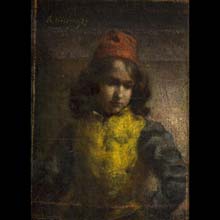
material: oil on canvas
dimensions: 27,5 × 20,5 cm
description: Seeking innovative colour and formal solutions, Gierymski turned to Northern Italian Renaissance painting. From the works of Venetian painters – Titian, Veronese, Tintoretto and Giorgione – he learned the skill of using colours to build and separate forms as well as to compose and harmonize the painting visually. The artist used a lighter palette, introducing pure light colours, developed the scale of chiaroscuro and improved the way of rendering the effects of reflection and glint on various materials and substances. He also adopted another essential value of art of the “great four” – the use of musical, tonal harmony of colours. It involved the abandoning of the linear contour, making shape less restricted, smoothening the transitions of colours with the use of graded half- and quarter-tones, delicate colour modulations, taking into account the scale and temperature of colours in building the mood of the painting. A Florentine Page is an excellent example of the achievements of Venetian painting adopted by Gierymski, the evidence of the artist’s unusual colour sensitivity and the high level of his painting skills. Wacława Milewska
exposition: The Gallery of 19th Century Polish Art in Sukiennice,
The Cloth Hall, 1, Main Market Square
key: Realism, polish impressionism, beginnings of symbolism >>>
dimensions: 27,5 × 20,5 cm
description: Seeking innovative colour and formal solutions, Gierymski turned to Northern Italian Renaissance painting. From the works of Venetian painters – Titian, Veronese, Tintoretto and Giorgione – he learned the skill of using colours to build and separate forms as well as to compose and harmonize the painting visually. The artist used a lighter palette, introducing pure light colours, developed the scale of chiaroscuro and improved the way of rendering the effects of reflection and glint on various materials and substances. He also adopted another essential value of art of the “great four” – the use of musical, tonal harmony of colours. It involved the abandoning of the linear contour, making shape less restricted, smoothening the transitions of colours with the use of graded half- and quarter-tones, delicate colour modulations, taking into account the scale and temperature of colours in building the mood of the painting. A Florentine Page is an excellent example of the achievements of Venetian painting adopted by Gierymski, the evidence of the artist’s unusual colour sensitivity and the high level of his painting skills. Wacława Milewska
exposition: The Gallery of 19th Century Polish Art in Sukiennice,
The Cloth Hall, 1, Main Market Square
key: Realism, polish impressionism, beginnings of symbolism >>>












